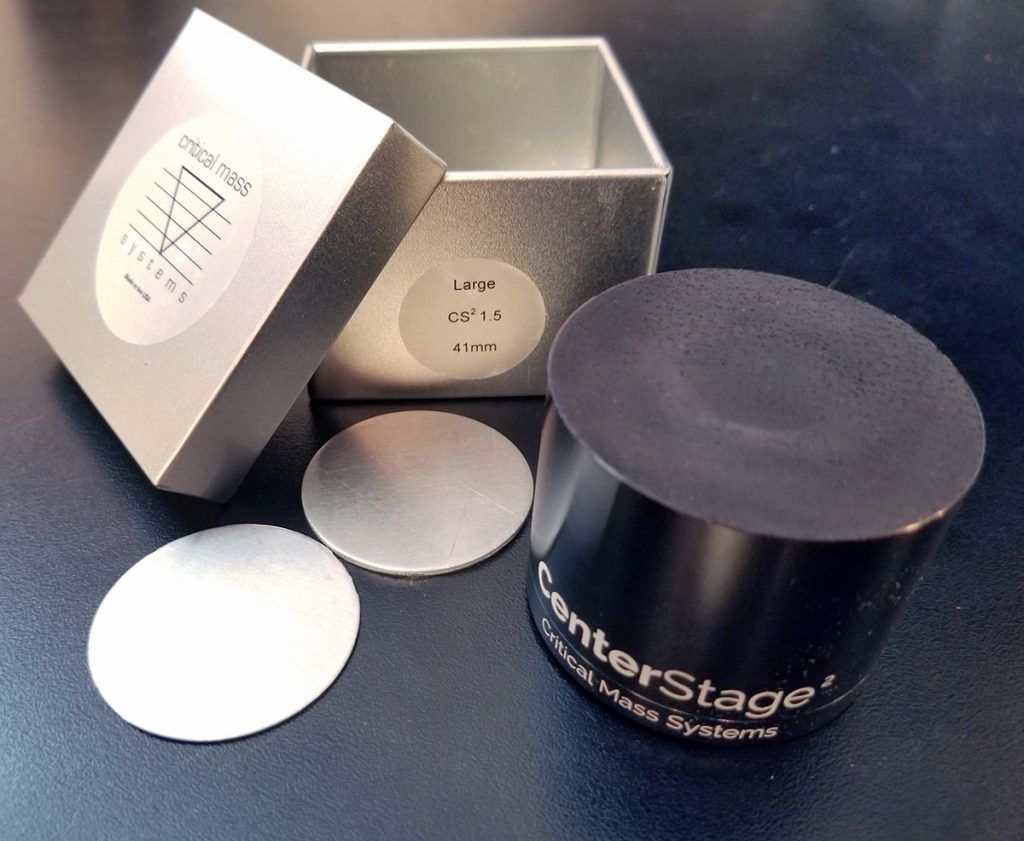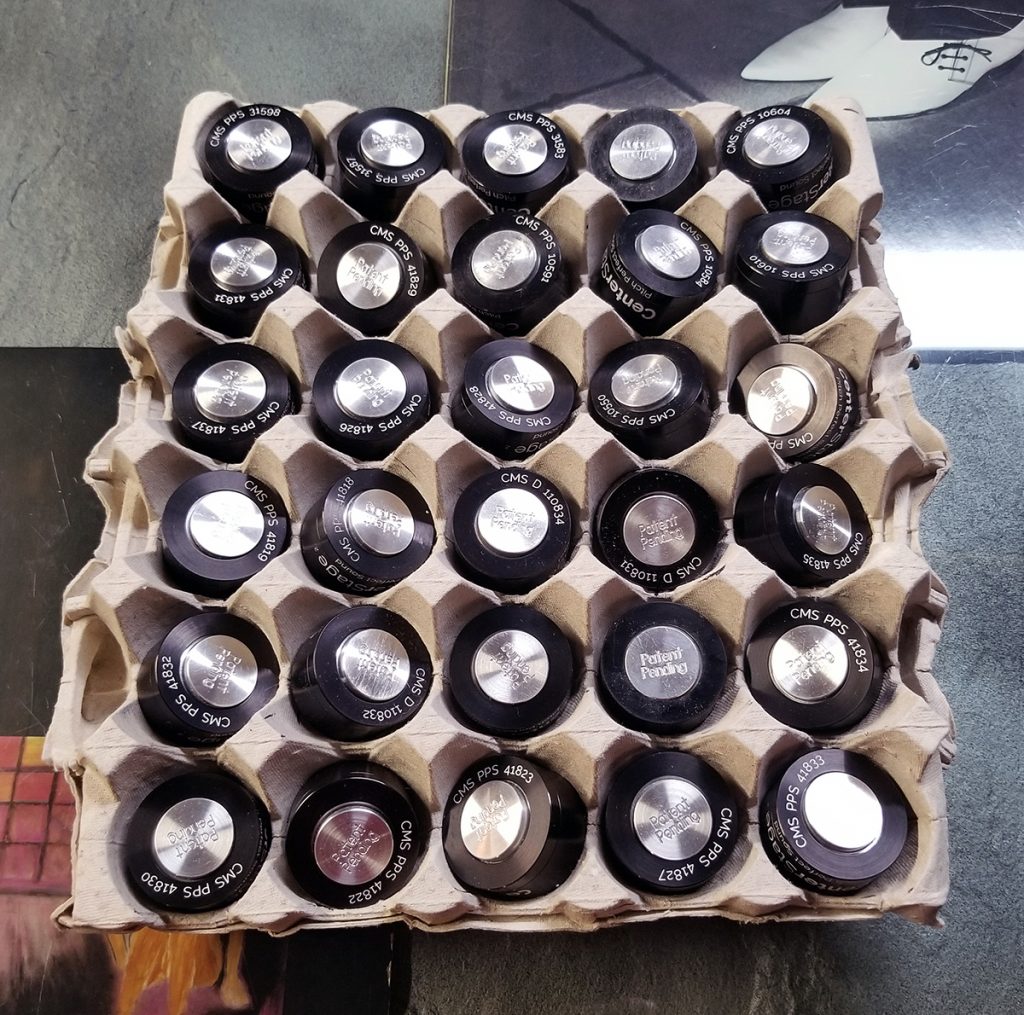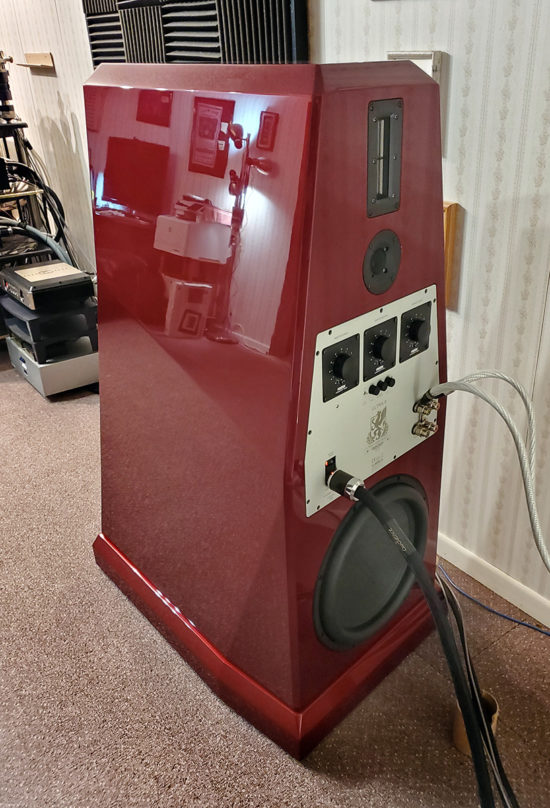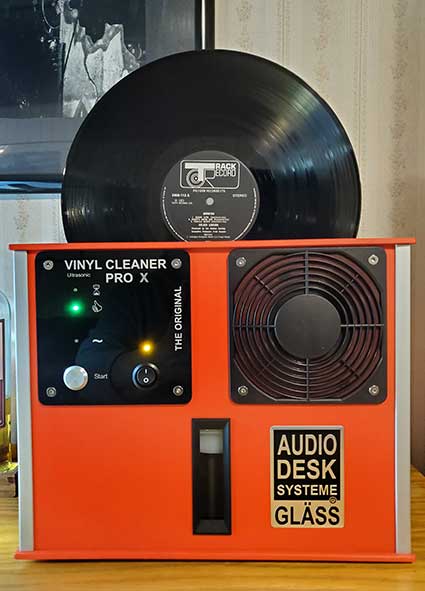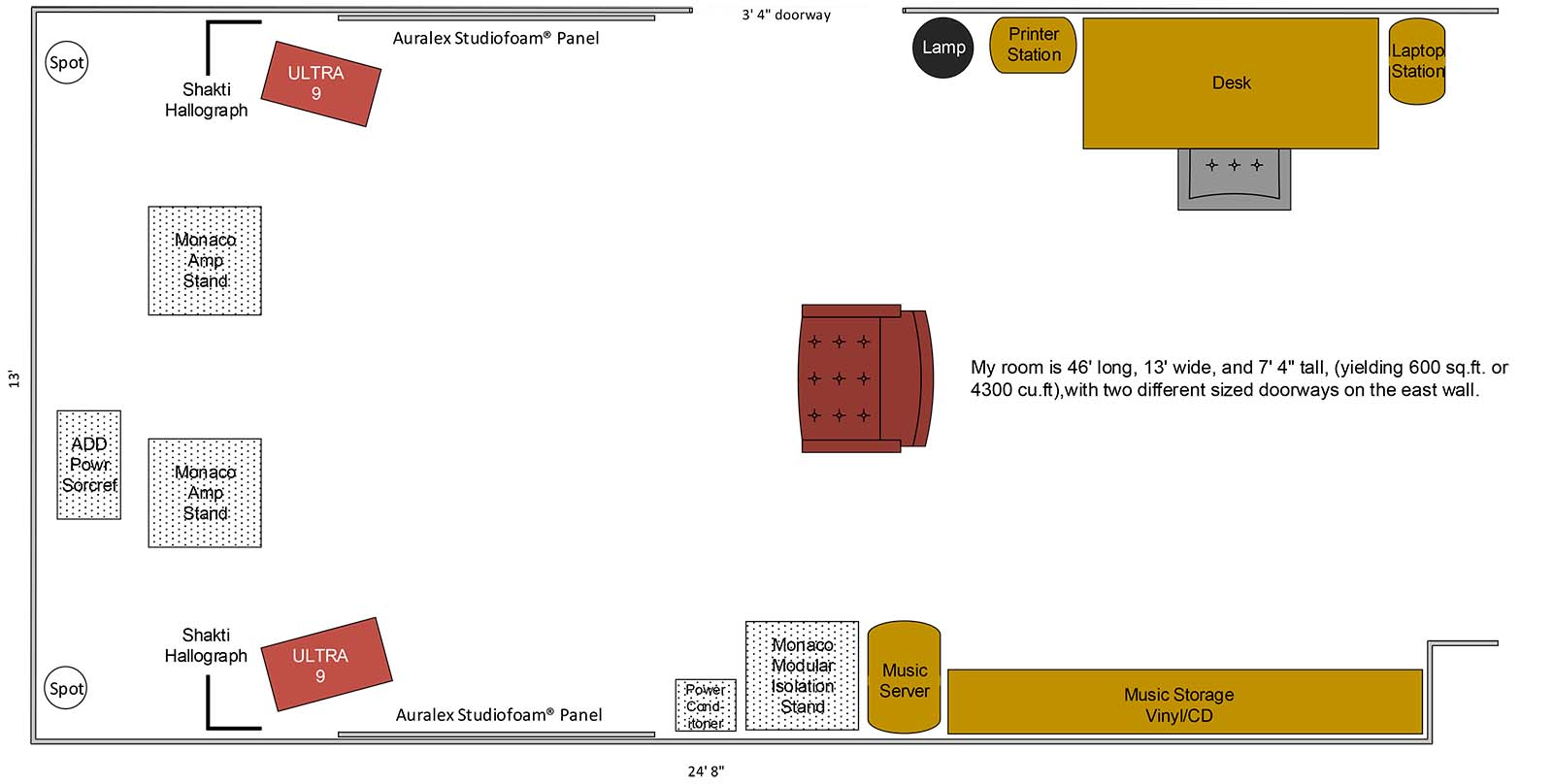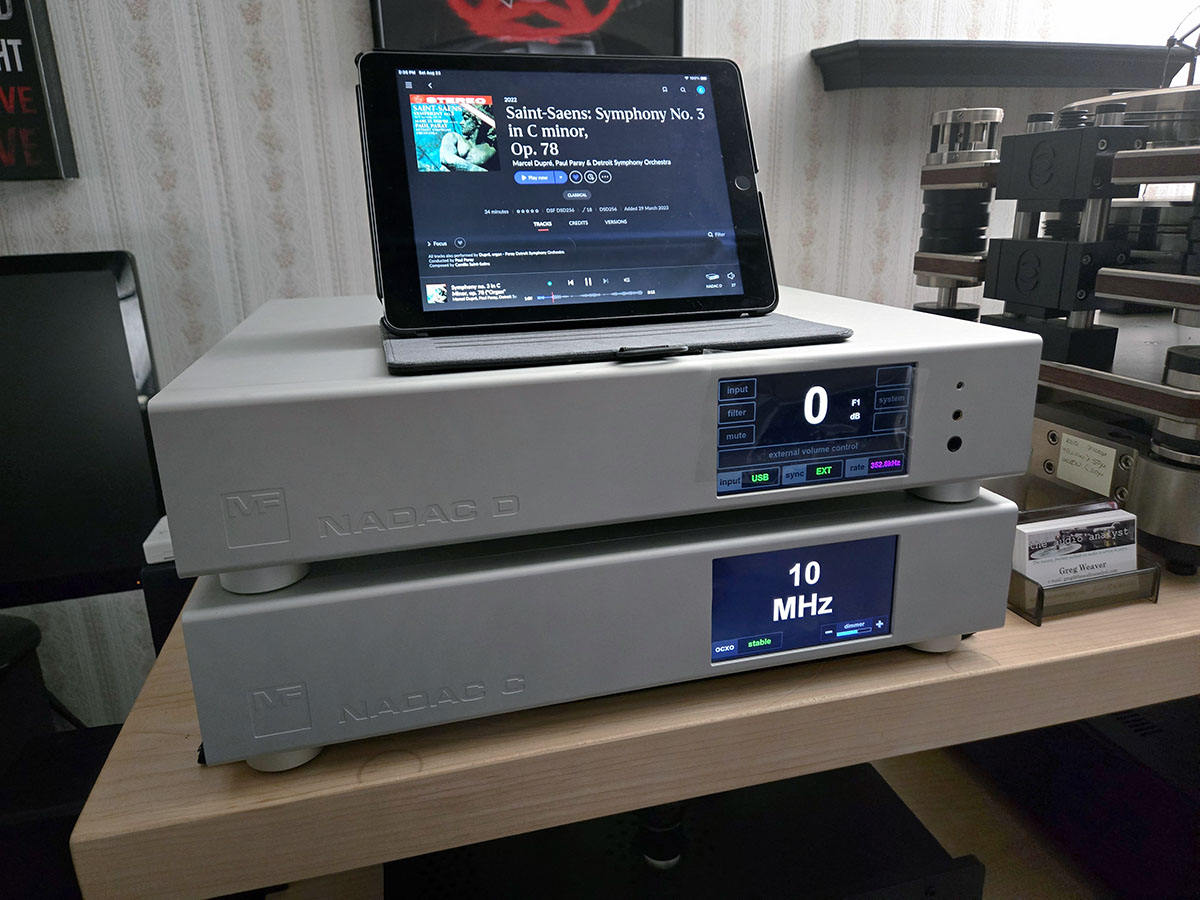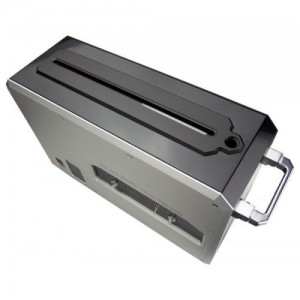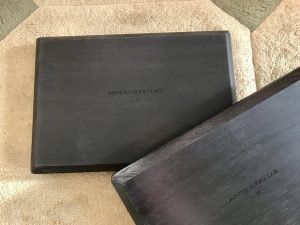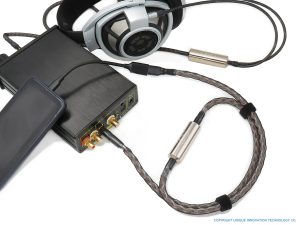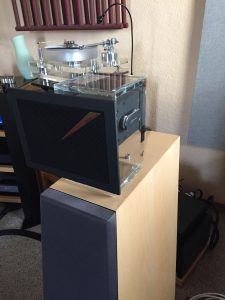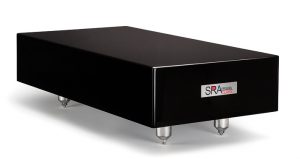The new 1.5-inch tall Critical Mass Systems CenterStage2 footer packaged with two different thickness of shims, provided to assure the best possible contact.
I've honestly no idea why I was so surprised to hear from Critical Mass Systems' Joe Lavrencik this past July asking if I'd like to audition the "new" CMS CenterStage2 footers. He has shown himself to be unrelenting in his pursuit of performance, so I suspect that it was because it was coming so closely on the heels of the publication of my profound experiences with the radically effective original CenterStage footers just some three months earlier (HERE). I must admit to being both skeptical and somewhat curious to see if these groundbreakingly effective devices could be improved upon—especially in such a short period.
Within weeks, my original thirty CenterStage footers were upgraded to thirty of the new CenterStage2 footers…with one additional consideration; he sent along eight additional new CS2 footers. Originally, the devices had been available in two height profiles, 0.8-inches and 1-inch tall, both at 1.5-inches in diameter. Now, with the superscript 2 iteration, a new 1.5-inch height is also available, all retaining the same 1.5 inch diameter. He also included four of the original 1-inch CS footers for direct comparison.
In Joe's original communications to me he mentioned that he felt the CS2 to be so effectively improved as to be regarded as a new product. In addition, he indicated that the CS2s effectiveness increased as they got taller, which turned out to be a very meaningful differentiation, as you shall soon discover.
In a very simplistic view, the Critical Mass Systems CenterStage2 footers act as a highly sophisticated "drain," a mechanical diode or sorts, for induced and generated vibration in the components that rest on them, giving that unwanted, corrupting energy a route out of and away from those components, thereby reducing disordered and chaotic resonance within the component itself, and converting and dissipating that energy as heat. Joe claims the reason that components take so long to settle in on these unique feet, and why the system's sonic signature swings so widely during that period, is related to the 2nd Law of Thermodynamics.
He explains as follows. "The principle is cross-border entropic transfer in reversible thermodynamic systems. Broadly speaking this principle recognizes that electromechanical systems experience internal disorder at the moment they are engaged (turned on). The commonly recognizable sign of entropy is the generation of heat, but there are others.
Dynamic systems can be reversible or irreversible. Human beings, for example, are irreversible biodynamic systems where entropy is retained, and equilibrium is ALWAYS reached. As we age, strange things happen at an accelerating pace. Our vision degrades. We might lose hair. Our joints sustain damage through wear and tear. Our muscles weaken. Eventually disease may set in and, after a time, the system shuts down completely. Even then bio-dynamic systems have residual energy. The energy is exhausted when the components of the system turn to dust. The 2nd Law implies that this is perfectly normal. Entropy accelerates in dynamic systems unless some portion of it can be transferred into another system.
On the other hand, electromechanical systems are reversible. With respect to audio components, a portion of naturally occurring and environmentally induced internal entropic disorder can be transferred into another system. Assuming that an external system (Center Stage, in this case) is specifically designed to facilitate the transfer and the external system is appropriately positioned to facilitate the transfer process, time is required to set the pathway and create a new electromechanical equilibrium point. Once settled in, Center Stage acts like a trash can that takes the "garbage" out to the curb when your system is playing music. There is also a 1st Law component to Center Stage with respect to mitigating noise as vibration moves upward through it (just like your very good Grand Prix racks), but it's the degree to which they help reduce disorder in the system above them that makes them unique."
From my ongoing conversations with Joe, the essence of what differentiates the superscript 2 version would seem to come down to both a substantive diminution of the inherent noise of the materials used to fabricate the footers combined with a diminishing of the upward movement of vibrational energy through them. Together with these decreases, Joe also states he has found a way to enhance their entropy, to increase the amount of energy transferred out of the components to the footers; essentially increasing their efficacy as "drains!"
At the time they were installed, my system included my Kronos Sparta turntable, Helena tonearm, and the Air Tight PC-1 MC cartridge, feeding my DSA Phono II phono stage. Digital was rendered by either my own Windows 10 based PC, using either J. River 24 (64-bit) or Roon 1.5, with Fidelizer v8.2, or my extensively modified McCormack UDP-1, both handing off to my Hegel HD30 DAC. My linestage is the Constellation Audio Inspiration 1.0, and I am using a pair of Constellation Audio 1.0 stereo amplifiers in a vertical biamp configuration to drive my Von Schweikert Audio VR-55 Aktive loudspeakers. Signal cabling is from Stealth Audio, with a Helios phono cable, Śakra V12 single-ended interconnects, and the Dream v14 speaker cables, while all power and the USB cable were flagship products from Audience. Power conditioning is managed with the PS Audio DirectStream P20 Power Plant, an Audience aR12-TSSOX, and 2 Quantum Symphony Pro's, with the total system investment just eclipsing the $300,000 mark.
My original set of thirty first generation devices included twenty-two of the 0.8-inch units, employed under my source components, DAC, linestage, phonostage, and external music media storage drives, and eight of the 1-inch units, four each under my mono amps. These thirty were initially replaced with the same profile of CenterStage2 footers. By allowing me to duplicate the original installation exactly, I would more effectively be able to judge the degree of improvement, if any, the CS2s deliver over the original CS version.
The thirty CS2 footers for my listening arrived in their bulk shipping "egg carton."
My listening began mid-day Sunday, Aug 5th, after some three days of reclamation listening following the removal of the original thirty CS footers. Once I had gotten used to the reduced level of performance, sans the remarkable magic wrought by the original CS footers, I was ready to proceed with the duplicate installation of CS2s.
Once installed, and the system back on, I immediately noted a clear loss of extension and control in the lowest regions, a lessening of the overall sweetness and air to treble, a general softening of detail from the upper midrange on up through the top octave, as well as a notable loss of focus and specificity to the staging and imaging. So, with those observations, I set my favorite run-in track to repeat on my music server, set the volume to about 60dB at my listening chair, and walked away for the night.
I had time for some brief listening in the late evenings of Tuesday, Aug 7th, and Wednesday, Aug 8th, days two and three. For both sessions I played music from my music server for about an hour, sampling from my most frequently used demo tracks. I found the system sounding rather dull and dry, surprisingly unengaging in nearly every way on Tuesday night. But it was almost unrecognizable and unlistenable during Wednesday's session. Bass extension was severely limited and was bloated and ill-defined. Leading edges were softened to the point of smearing, and midrange focus and specificity were diffuse and amorphous. Worst of all, there had been a distinctly cooler shift in timber. I finished up my notes and restarted the run-in track.
I had no time to listen on Thursday, Aug 9th, but by Friday evening, the 10th, I was treated to a little of the old CS magic. For the entire four and a half hours of that listening session, which I shared with a good friend, sampling his LPs as well as mine (this time it was an exclusively analog session), we were transfixed. Bass and midrange bloom and body had returned, as had a large portion of the previously missing sparkle and air above about 3,500Hz. The sound bordered on beguiling and sounded much more engaging and involving than it had in previous weeks. And not by any small margin. We finished our session excited and moved. It had been a highly emotional listening session. After I bid my friend goodnight, I restarted the burn-in track.
I noticed minor performance variations over that Saturday's listening, on the 11th, but by the evening of Sunday the 12th, all that Friday night magic, and more, was back. I was transfixed during my early evening listening and took a lot of notes.
The most obvious improvements could be distilled into three categories; a substantially lowered noise floor, remarkably improved warmth, with more realistic body, more natural tone and texture, and a vastly enriched, more enveloping and immersive soundstage.
First and foremost, there was a laid-back, relaxed ease to the presentation that just drew me into the music. The overall noise floor had seemed to plummet, even lower than I had recalled with the original CS footers in place. The resultant stillness this afforded, by way of a darker, starker, background, was just intoxicating, adding a power and persuasiveness to everything I played, allowing me to be informed as much by the silence between musical impulses as by the effortless drive and pace of the musical gestalt itself.
Instrumental tone colors, including their textures and verve, had bloomed. There was a newfound effortlessness and neutrality to every aspect of the music I played now, even with my digital rig, which cannot quite match my analog front end in this respect. And this sense of neutrality, of naturalness, of faithfulness, was broad-band, extending from the deepest reaches of the bass to include a newfound shimmer and sparkle in the uppermost octaves. My Von Schweikert Audio VR-55 Aktive's custom-built Scan-Speak Beryllium tweeters seemed to be even more unrestrained than ever, allowing them to develop that sense of graceful effortlessness, of unfettered extension, replete with the perception of the air of and around instrumental voices that allows them to regenerate that final, compelling measure of attack, decay, and trailing ambiance.
And what a spatial presentation! My initial sensation of three-dimensionality, that enveloping immersiveness bordering on surround-sound that the original CS footers had created so effortlessly, was back, but was even more apparent and unmistakable. The presentation I was hearing from my reference two-channel system was approaching the spatial characteristics rendered by an exceptionally well setup 5.1 multi-channel music surround system!
Over the next two weeks, I honestly didn't notice any significant relapses or advances from the powerful performance I had first witnessed on that seventh night. Does this mean the CS2s settle more rapidly than their predecessors, that they are more effective overall? I can't say with absolute certainty, but I suspect those observations to be true.
But now I had another question. What improvements, if any, might I be treated to if I removed the 1-inch models from under my mono amplifiers and replaced them with the 1.5-inch CS2s waiting in the wings, then replaced the 0.8-inch models underneath my linestage and phono stage with the recently freed 1.0-inch models?
Four of the 1.5-inch (the fourth hidden by the prominent front right unit) CenterStage2 footers in place under one of my mono amplifiers on a separate amplifier stand.
I made that change on Monday night, August 27th, and was somewhat surprised that the change had not caused as great a diminishment in overall performance as had the original reinstallation of the thirty CS2s. After all, I had just disturbed the settled performance of over half (sixteen of thirty) of all the CS2s in play. Perhaps they would take some time to loose the state of equilibrium they had already attained. I've no idea, that is just what I speculated. But honestly, I didn't spend a lot of time listening after that change and having noted my initial impression. I just set my music server to repeat my run-in track and let it play at about 60dB one more time.
By Thursday, August 30th, I was utterly shocked by what I was hearing, and by Saturday, September 1st, I was simply knocked out by the transformation! The most notable developments after this change were much deeper, more powerful, and substantially more defined pitch in the bass, a decisively more accurate tonal shift, and a deepening and tightening of focus of imaging and soundstaging cues, which had become even more expansive, more enveloping, and more accurately sized. By Sunday September 2nd, I was having trouble believing so much change could be wrought by such ostensibly minor changes. It was as if my linestage, mono amps, and sources, even my loudspeakers, had all been replaced by components that were at least two to three times more expensive!
My initial impressions with the direct replacement of all the original CS devices with the same sized CS2 devices was that the CS2s delivered on the order of 25 to 40% improvement. To be honest, that represents a staggeringly large percentage increase. But the improvements wrought by the application of the 1.5-inch tall CS2s are almost indescribable and otherwise unattributable! What they bring to the game in terms of enhanced, articulated bass, more faithful tonal purity, and more enriched and accurate spatial enhancement is beyond my ability to label. They are that good!
To say that the Critical Mass Systems CenterStage2 footers are game changers may be the father of all understatements. In closing my review of the original CenterStage footers, I opined that they should not be considered as optional accessories but were indispensable necessaries! Doubly so, the CenterStage2 footers. They are so remarkable, in fact, that companies as prestigious as Swiss electronics manufacturer Soulution have begun to install them at manufacture as the factory feet on their products, with several other companies planning to follow suit.
The CenterStage2 footers are so significantly better than any other single footer, cone, or isolation device I have experienced over the past 35 years, that comparing them, or trying to equate their effectiveness in any manner, would be to insult the accomplishments attained by the CMS CenterStage2.
While the thirty CS2 devices employed in my installation carried a retail value of $12,640, that still represented an additional investment of only about 4 ¼ percent. Yet, the degree of performance enhancement they rendered in that otherwise remarkable sounding system was staggering! I honestly don't believe that I could reap this significant a sonic improvement if I were to double the total invested price of my system, maybe even if I were to triple it! They truly are that effective.
These devices represent a near quantum leap forward in their ability to unlock and release the most faithful and accurate voice your equipment can recreate. They allow the purity and clarity of its true voice, a voice that has previously been masked and contaminated by the unaddressed destructive, polluting forces of vibrational energy, thereby setting a ridiculously high benchmark of performance. What Joe Lavrencik has achieved with the Critical Mass Systems CenterStage2 footer is to realize the otherwise unfulfilled promise such products have heralded from their inception in 1983 and should be seen as more than merely an order of magnitude of improvement in the performance of the now 35-year-old "footer" product category. No, they aren't cheap. But they represent the highest degree of value obtainable from any isolation device known to me, and the single most effective way I've yet found to release the utmost best from your system, period.
Critical Mass Systems Center Stage2 Footers
Retail: CenterStage2 0.8-inch $320 each. Buy 3, and the 4th is included free. $960 for a set of 4
Retail: CenterStage2 1.0-inch $445 each. $1780 for a set of 4
Retail: CenterStage2 1.5-inch $695 each. $2780 for a set of 4
Critical Mass Systems
www.criticalmasssystems.com
Call or contact your closest Critical Mass Systems dealer for more information




